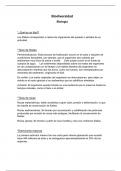Class notes
Biodiversidad - Biología
- Course
- Institution
En este documento se habla sobre los fósiles, que son, como se clasifican, en donde es mas probable encontrarlos, por ejemplo en las rocas sedimentarias. También se habla sobre las cinco extinciones masivas, así como el registro fósil, los estratos en donde se encuentran diferentes fósiles gu...
[Show more]



